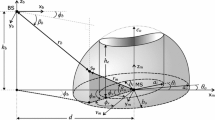Abstract
The deployment of millimeter waves (mmW) in 5G mobile networks is considered as a challenging issue due to the lack of knowledge regarding the propagation of mmW in such multipath fading environments. Therefore, the analysis and modeling of such mobile fading channels is required. In this paper, we investigate the space–time correlation functions for multiple-input multiple-output (MIMO) channels in mmW frequency bands. We develop a 3-D geometry-based channel model for Rician channel to overcome the multipath fading. Such a model is able to provide a realistic channel propagation with multiple antenna elements surrounded by a scattering environment. We derive the space–time correlation functions for the scattering environments in terms of the different system parameters of the MIMO fading channel. We present the numerical evaluations to study the influence of the system parameters such as normalized time delay, vertical and horizontal antenna polarization, and separation between antenna elements on the performance of the space–time correlation functions.








Similar content being viewed by others
References
Rappaport, T. S., et al. (2015). Millimeter wave wireless communications. Upper Saddle River: Pearson/Prentice Hall.
Azar, Y., Wong, G. N., Wang, K., Mayzus, R., Schulz, J. K., Zhao, H., et al. (2013). 28 GHz propagation measurements for outdoor cellular communications using steerable beam antennas in New York City. In 2013 IEEE international conference on communications (ICC), Budapest (pp. 5143–5147).
MacCartney, G. R., & Rappaport, T. S. (2017). 73 GHz millimeter wave propagation measurements for outdoor urban mobile and backhaul communications in New York City. In 2014 IEEE international conference on communications (ICC), Sydney, NSW (pp. 4862–4867).
MacCartney, G. R., Samimi, M. K., & Rappaport, T. S. (2014). Omnidirectional path loss models in New York City at 28 GHz and 73 GHz. In 2014 IEEE 25th annual international symposium on personal, indoor, and mobile radio communication (PIMRC), Washington DC (pp. 227–231).
Rappaport, T. S., Murdock, J. N., & Gutierrez, F. (2011). State of the art in 60-GHz integrated circuits and systems for wireless communications. In Proceedings of the IEEE (Vol. 99, no. 8, pp. 1390–1436).
Rappaport, T. S., et al. (2013). Millimeter wave mobile communications for 5G cellular: It will work! IEEE Access, 1, 335–349.
3GPP TR 36.873. (2014). Study on 3D channel model for LTE. Release 12, v1.3.0, February, 2014. www.3gpp.org. Accessed 25 Jan 2016.
Samimi, M. K., & Rappaport, T. S. (2014). Ultra-wideband statistical channel model for 28 GHz millimeter-wave urban NLOS environments. In 2014 IEEE global telecommunications conference, Austin, Texas.
Samimi, M. K., & Rappaport, T. S. (2015). 3-D statistical channel model for millimeter-wave outdoor mobile broadband communications. In 2015 IEEE international conference on communications (ICC), London (pp. 2430–2436).
Aulin, T. (1979). A modified model for the fading at a mobile radio channel. IEEE Transactions on Vehicular Technology, 28(3), 182–203.
Turkmani, A. M. D., & Parsons, J. D. (1991). Characterization of mobile radio signals: Model description. In IEE proceedings I—Communications, speech and vision (Vol. 138, no. 6, pp. 549–556).
Abdi, A., & Kaveh, M. (2002). A space–time correlation model for multielement antenna systems in mobile fading channels. IEEE Journal on Selected Areas in Communications., 20(3), 550–560.
Zajic, A. G., & Stuber, G. L. (2008). Three-dimensional modeling, simulation, and capacity analysis of space–time correlated mobile-to-mobile channels. IEEE Transactions on Vehicular Technology, 57(4), 2042–2054.
Michailidis, E. T., & Kanatas, A. G. (2010). Three-dimensional HAP-MIMO channels: Modeling and analysis of space–time correlation. IEEE Transactions on Vehicular Technology, 59(5), 2232–2242.
Stuber, G. L. (2001). Principle of mobile communication (2nd ed.). Boston, MA: Kluwer.
Zajic, A. (2013). Mobile-to-mobile wireless channels. Norwood: Artech House.
Pätzold, M. (2012). Mobile radio channels (2nd ed.). Hoboken: Wiley.
Paulraj, A., Nabar, R., & Gore, D. (2003). Introduction to space–time wireless communications. Cambridge: Cambridge University Press.
Zajic, A. G., & Stuber, G. L. (2008). Space–time correlated mobile-to-mobile channels: Modelling and simulation. IEEE Transactions on Vehicular Technology, 57(2), 715–726.
Salz, J., & Winters, J. H. (1994). Effect of fading correlation on adaptive arrays in digital mobile radio. IEEE Transactions on Vehicular Technology, 43(4), 1049–1057.
Pedersen, K. I., Mogensen, P. E., & Fleury, B. H. (1997). Power azimuth spectrum in outdoor environments. Electronics Letters, 33(18), 1583–1584.
Clarke, R. H., & Khoo, W. L. (1997). 3-D mobile radio channel statistics. IEEE Transactions on Vehicular Technology, 46(3), 798–799.
Taga, T. (1990). Analysis for mean effective gain of mobile antennas in land mobile radio environments. IEEE Transactions on Vehicular Technology, 39(2), 117–131.
Kuchar, A., Rossi, J. P., & Bonek, E. (2000). Directional macro-cell channel characterization from urban measurements. IEEE Transactions on Antennas and Propagation, 48(2), 137–146.
Gradshteyn, I. S., & Ryzhik, I. M. (1994). Table of integrals, series, and products (5th ed.). San Diego, CA: Academic.
Clarke, R. H. (1968). A statistical theory of mobile-radio reception. Bell System Technology Journal, 47(6), 957–1000.
Shiu, D., Foschini, G. J., Gans, M. J., & Khan, J. M. (2000). Fading correlation and its effect on the capacity of multielement antenna systems. IEEE Transaction on Communications, 48(3), 502–513.
Leong, S. Y., Zheng, Y. R., & Xiao, C. (2004). Space–time fading correlation functions of a 3-D MIMO channel model. In Proceedings of IEEE WCNC, Atlanta, GA (Vol. 2, pp. 1127–1132).
Author information
Authors and Affiliations
Corresponding author
Additional information
Publisher's Note
Springer Nature remains neutral with regard to jurisdictional claims in published maps and institutional affiliations.
Rights and permissions
About this article
Cite this article
Eldowek, B.M., Abd El-atty, S.M., El-Rabaie, ES.M. et al. 3D Modeling and Analysis of the Space–Time Correlation for 5G Millimeter Wave MIMO Channels. Wireless Pers Commun 104, 783–799 (2019). https://doi.org/10.1007/s11277-018-6051-4
Published:
Issue Date:
DOI: https://doi.org/10.1007/s11277-018-6051-4




